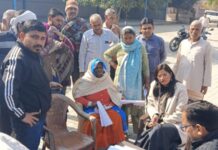HOW ADP HAS ADDRESSED REGIONAL DISPARITY
Amitabh Kant
Nagaland’s Kiphire is one of the most remote districts of India, located in a challenging hilly terrain. Most people in the district are engaged in agriculture and related activities, with kholar or kidney beans being a popular choice. Recognizing the potential of kholar cultivation in improving the livelihoods of the locals, a packaging facility for the same was set up in 2019 through the Aspirational Districts Programme. The facility was an instant hit with the farmers. Since then, kholar cultivation has taken off in a big way and Kiphire’s kidney beans are now being sold across the country on the TribesIndia.com portal of the Ministry of Tribal Affairs.
Similar success stories abound across the 112 districts that are a part of the Aspirational Districts Programme (ADP), launched by the Prime Minister in 2018. Since its inception, ADP has consistently worked towards boosting growth and development of some of the most backward and remote districts of India.
Earlier this year, UNDP lauded the programme as ‘a very successful model of local area development’ that ‘should serve as a best practice for several other countries where regional disparities in development status persist for many reasons’. In 2020, the Institute of Competitiveness too recognized the far-reaching impact of the programme on the most under-developed pockets of India.
Since the inception of the programme, significant improvement in health, nutrition, education and infrastructure has been noted, along with positive social and economic impact. According to Round 5, Phase 1, of the National Family Health Survey, in critical care areas—such as antenatal care, institutional deliveries, child immunization, use of family planning methods—the aspirational districts have shown relatively faster improvement. Similarly, in basic infrastructure provision, access to electricity, cleaner fuel and sanitation, the districts have moved relatively faster.
The programme has been able to achieve these results by tracking and ranking the performance of the districts on 49 key performance indicators (KPIs) across five sectors: health and nutrition, education, agriculture and water resources, basic infrastructure, financial inclusion and skill development.
ADP’s focus on improving governance in these districts has not only improved the delivery of government services but also given rise to dynamic and innovative efforts led by the districts themselves.
The design of ADP recognizes two important realities. First, that lack of funding is not the sole or even the predominant cause of backwardness as due to poor governance funds available under existing schemes (both central and state) are not effectively utilized. And second, the prolonged historical neglect of these districts has created a vicious cycle of low motivation among district officials. Breaking this cycle through the infusion of data-driven governance is in fact the key to unlocking the potential of these districts.
During its three years of implementation, the programme has provided the right institutional framework to push substantial improvement across a multitude of sectors through its core principles of convergence (between central and state schemes), collaboration (between centre, state, district and development partners) and competition (between the districts).
Through ADP, the government is using technology to not only streamline coordination but also channelise efforts in a targeted manner. ADP’s Champions of Change platform, developed by NITI Aayog, supports the district administration with self-service analytics tools, which aids them in analysing data and developing targeted local area plans. The platform ensures that the districts are constantly competing with each other in order to improve their position in the programme’s delta rankings. Competition ensures that new ideas to improve service delivery are constantly being explored.
While several schemes have tried to address regional disparities over the years, there has been very little convergence between them. By measuring the districts on the 49 KPIs, ADP leaves them with the discretion to streamline and channel the schemes that can best enable them to achieve outcomes. In this way, development efforts go beyond the scope of individual schemes and are viewed through the prism of the results they are intended to bring. This convergence of central, state, and district-level efforts is one of the founding principles of ADP.
The programme has brought together NGOs/civil society organisations and district administration to work in collaboration with each other, as opposed to duplicating efforts or working in silos. This has ensured that sarkar, samaaj and bazaar all work towards achieving the same objectives by leveraging their respective assets.
Over the years, the districts have been able to benefit from each other through the circulation and replication of best practices. Certain practices innovated and adopted by one district have been replicated by others. The programme allows such inspiration to flow across districts, along with the necessary flexibility to mutate the practices as per local requirements.
The Aspirational Districts Programme is highly cognizant of the differences across states and even districts and provides a suitable mechanism to allow for those differences. In fact, the programme intends to deepen this vision by encouraging districts to replicate this model at the block level. We hope that taking the model further will provide deeper insights into the challenges faced by a district and how to overcome them.
ADP is a shining example of cooperative–competitive federalism. The recognition and recommendations from international organisations about ADP’s template and successes validate our efforts immensely. In fact, it is only fitting that a model to address regional disparities should come from one of the most diverse countries in the world, and we are committed to evolving the programme to one of the best instruments of equalising development.
Amitabh Kant is CEO, NITI Aayog. Views expressed are personal.

















